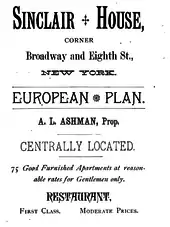| Sinclair House | |
|---|---|
 | |
| General information | |
| Location | 8th St. and Broadway, Manhattan, New York City |
| Coordinates | 40°43′48″N 73°59′31″W / 40.730°N 73.992°W |
| Demolished | 1908 |
Sinclair House was a 19th-century hotel which stood at 754 Broadway[1] and Eighth Street in Manhattan, New York City.[2][3] It was demolished in 1908.[4]
History
Part of what became the Sinclair House was constructed around 1787, on land purchased by Frederick Charles Hans and Baron Bruno Poelintz from John Jay, Isaac Roosevelt, and Alexander Hamilton.[5] It opened as a roadhouse in 1840, and was purchased by Robert Sinclair around 1855, and then known as the Sinclair House.[6] It catered to downtown businessmen and commercial travelers, and was well-known to the booktrade.[7][6]
Amaziah L. Ashman was proprietor of Sinclair House from 1863 until his death in 1902. In the first part of that period, he was a partner with James Morton in the venture, and later became sole owner.[8] Ashman was a native of Livingston County, New York and the director of Astor Place Bank.[9][10] His New York Times obituary described him as "one of the best-known hotel keepers in this country."[10]

After Ashman died, his widow thereafter operated the hotel until it closed on April 4, 1908, the same day that the Fifth Avenue Hotel closed.[11][12][13]
Visitors to Sinclair House included Horace Greeley, William Cullen Bryant, Grover Cleveland, and Sam Ward, the namesake for the hotel restaurant's "Sam Ward Steak." The restaurant in the hotel was well known, described by one New York paper in 1920 as "celebrated for its toothsome terrapin, its canvasback ducks, its turtle soup, its oyster and tripe stews, no less than for its more plebeian corned beef and cabbage."[14]
Francis Marion Crawford's novel Katharine Lauderdale was partially written while he stayed there, and its events are laid out in the same neighborhood. Henry Cuyler Bunner stayed there while writing Short Sixes and his Washington Square stories. Other well-known guests included playwright Paul Potter and explorer Paul Du Chaillu.[11]

The Sinclair House hosted many events. For example, in November 1863 it hosted a meeting of the mayoralty convention of New York City and the County of New York, organized by the Democratic Party general committee.[15] The same month the establishment was the location of delegate selection of several conventions pertinent to the 5th Ward Union Association.[16]
Replacement building
The hotel was demolished shortly after closing in April 1908 to make way for an office building.[14][6][7][17] A 12-story building was constructed in 1908–09, aka "The Sinclair Building", and is still standing as of 2015.[18][19]
See also
References
- ↑ World Almanac, Facts on File, Newspaper Enterprises Association, 1901, pg. 533.
- ↑ Brooklyn Daily Eagle Almanac, American Almanac Collection, Library of Congress, 1901, pg. 206,.
- ↑ Proceedings of the Annual Meeting of the New York State Bar Association, Volume 37, Boyd Printing Company, 1914, pg. 440.
- ↑ The greatest street in the world, Stephen Jenkins, G.P. Putnam's Sons, 1911, pg. 187.
- ↑ (4 April 1908). Sinclair House To Go, The Sun
- 1 2 3 (9 May 1908). Old Booktrade Landmarks Disappear, Publisher's Circular, p. 601.
- 1 2 (4 April 1908). Old Sinclair House to Go. Closes To-night and Will Give Way to an Office Building, The New York Times
- ↑ (22 October 1902). A.L. Ashman Seriously Ill, The New York Times
- ↑ Biographical directory of the state of New York, 1900, Biographical directory co., New York, pg. 13.
- 1 2 (25 October 1902). Death of A.L. Ashman. Veteran Hotel Keeper, Proprietor of the Sinclair House, Succumbs to Intestinal Disease, The New York Times
- 1 2 (9 May 1908). New York Landmarks Going, The American Stationer, p. 6
- ↑ (28 May 1918). Mrs. A.L. Ashman, The Sun, p. 9 (Ashman's widow died on May 26, 1918)
- ↑ (4 April 1908). Sinclair House Closes To-Night. Famous Old Hostelry To Be Torn Down to Make Way for Office Building, New York Tribune, p. 8, col. 2.
- 1 2 (6 June 1920). City's Famous Hotels Now Part of History, The Sun and New York Herald, Section 7 Sunday Magazine, p. 5
- ↑ C. Godfrey Gunther and the Mayoralty, New York Times, November 7, 1863, pg. 2.
- ↑ Political, New York Times, November 14, 1863, pg. 7.
- ↑ (12 April 1908). Philadelphia Capital in Broadway Operation – Martin Maloney in the Company which Will Build on Old Sinclair House Site – New Sixteen-Story Building Will Cost $425,000, The New York Times
- ↑ NoHo Historic District, Designation Report Archived 2013-03-26 at the Wayback Machine, NYC Landmarks Preservation Commission (1991), pp. 92–93
- ↑ (8 May 1913). William J. Fanning – Hotel Men's Lawyer and Member of Many Clubs Is Dead, The Sun, p. 9 (obituary for William J. Fanning, son-in-law of A.L. Ashman)
External links
- 1895 photo at New York Heritage digital collections
- 1900 Menu for Sinclair House, New York Public Library (note steaks with more expensive "a la Sam Ward" option)
- Sinclair House records (1893–1908) information, New York Public Library Archives & Manuscripts